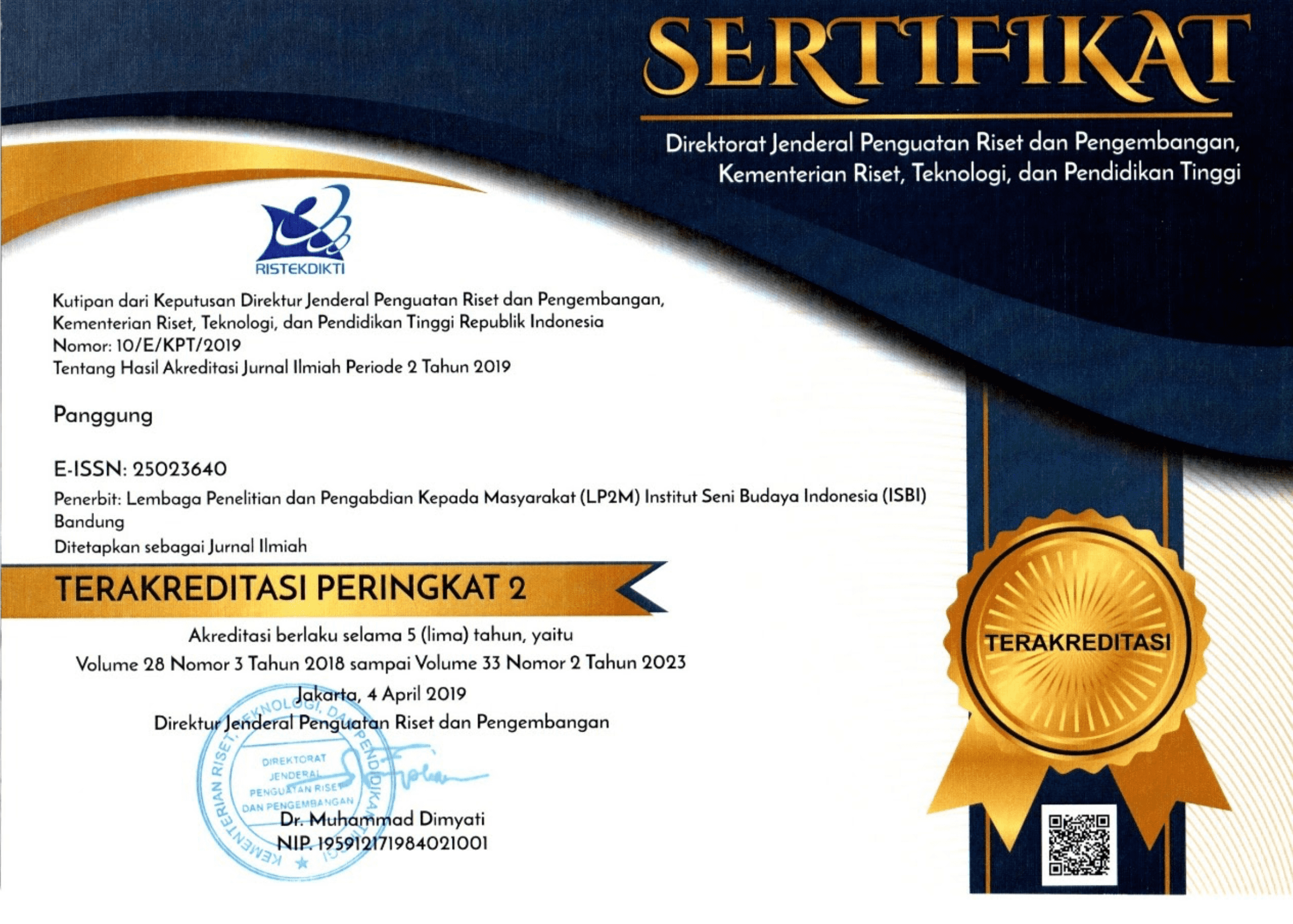Ideologi Sosial Dalam Kesenian Tradisional Angklung Sered: Dari Alat Perjuangan Hingga Sebagai Sarana Hiburan Masyarakat
DOI:
https://doi.org/10.26742/panggung.v33i2.2586Abstract
References
Adhi, M. K. (2016). The strategy of cultural poverty alleviation based on empowering local genius. International Journal of Science and Research (IJSR), 5(11), 1569–1573. https://doi.org/10.21275/ART20163124
Ani, M. (2016). WACANA BUDAYA SUNDA DAN IDEOLOGI DI DALAM TAYANGAN SINETRON (Analisis Semiotika Sinetron “Preman Pensiun 2”).
Ardini, N. W. (2015). Industrialisasi Musik Pop Bali: Ideologi, Kepentingan, dan Praktiknya. Segara Widya: Jurnal Penelitian Seni, 3.
Ardini, N. W. (2018). Reconstruction of social ideology through the power of music: Case study of Suntaraporn band, Thailand. Kasetsart Journal of Social Sciences, 39(2), 343–350. https://doi.org/10.1016/j.kjss.2018.05.003
Banton, M. (2014). Arts and Aesthetics in a Globalizing World.
Blaikie, N., & Priest, J. (2019). Designing social research: The logic of anticipation. John Wiley & Sons.
Brandon, L. (2006). Art Or Memorial?: The Forgotten History of Canada’s War Art. University of Calgary Press Calgary.
Bryman, A. (2016). Social research methods. Oxford university press.
Carey, M., & Foster, V. (2013). Social work, ideology, discourse and the limits of post-hegemony. Journal of Social Work, 13(3), 248–266.
Chambers, E. (2018). Soul of a Nation: Art in the Age of Black Power. Journal of Visual Art Practice, 17(2–3), 225–227.
De La Fuente, E. (2014). Why aesthetic patterns matter: Art and a “qualitative” social theory. Journal for the Theory of Social Behaviour, 44(2), 168–185.
Dissanayake, E. (2011). Doing without the ideology of art. New Literary History, 42(1), 71–79.
Frolova, E. L. (2008). Ethnic and Cultural Functions of Name in Traditional Japanese Society. Archaeology, Ethnology and Anthropology of Eurasia, 35(3), 105–112. https://doi.org/10.1016/j.aeae.2008.11.009
Gibbs, G. R. (2018). Analyzing qualitative data (Vol. 6). Sage.
Hauser, A. (1971). Propaganda, ideology and art. Aspects of History and Class Consciousness, 128–152.
Hennink, M., Hutter, I., & Bailey, A. (2020). Qualitative research methods. Sage.
Hillebrand, J. D., & Berg, B. L. (2000). Qualitative Research Methods for the Social Sciences. In Teaching Sociology (Vol. 28, Issue 1). https://doi.org/10.2307/1319429
Jost, J. T. (2006). The end of the end of ideology. American Psychologist, 61(7), 651.
Jost, J. T., Federico, C. M., & Napier, J. L. (2009). Political ideology: Its structure, functions, and elective affinities. Annual Review of Psychology, 60, 307–337.
Kotthoff, H. (1995). The social semiotics of Georgian toast performances: Oral genre as cultural activity. Journal of Pragmatics, 24(4), 353–380. https://doi.org/10.1016/0378-2166(94)00063-K
Lisa Jean Moore, M. J. C. (2015). The Body Social and Cultural Dissections. Routledge.
Lukmana, I. (2010). Analisis bahasa untuk kajian sosial: pemaknaan kritis terhadap praktek berwacana sebagai praktek sosial. Udayana University.
Mason, J. (2017). Qualitative researching. sage.
McLelland, D. (1995). Ideology. Buckingham. Open University Press.
Mills, C. W. (2005). “Ideal theory” as ideology. Hypatia, 20(3), 165–183.
Morrison, K. (2006). Marx, Durkheim, Weber: Formations of modern social thought. Sage.
Nafstad, H. E., & Blakar, R. M. (2012a). From an individualized to a societal social psychology: Ideology and ideological changes as reflected in language usage. Annual Review of Critical Psychology, 10, 741–755.
Nafstad, H. E., & Blakar, R. M. (2012b). Ideology and social psychology. Social and Personality Psychology Compass, 6(4), 282–294.
Pope, C., Ziebland, S., & Mays, N. (2000). Analysing qualitative data. Bmj, 320(7227), 114–116.
Purvis, T., & Hunt, A. (1993). Discourse, ideology, discourse, ideology, discourse, ideology... British Journal of Sociology, 473–499.
Ritchie, J., Lewis, J., Nicholls, C. M., & Ormston, R. (2013). Qualitative research practice: A guide for social science students and researchers. sage.
Satori, A., & Andrias, M. A. (2012). Pergerakan Prilaku Politik Islam Tradisional Pasca Pemilu Legislatif tahun 2009 di Kota Tasikmalaya. Jurnal Ilmu Politik Dan Pemerintahan, 1(1), 53–70.
Sawitri, S., Sudardi, B., Abdullah, W., & Chaya, I. N. (2020). Ideology of Bedhayan Dance in Surakarta in Globalization Era.
SAWYER, K. (2019). Creativity as a Process. The Creativity Reader, 385.
Schreier, M. (2012). Qualitative content analysis in practice. Sage publications.
Thompson, J. B. (2013). Ideology and modern culture: Critical social theory in the era of mass communication. John Wiley & Sons.
Varshney, L. R., Rajani, N. F., & Socher, R. (2020). Explaining Creative Artifacts. ArXiv Preprint ArXiv:2010.07126.
Webb, R., Schratz, M., & Walker, R. (1996). Research as Social Change, New Opportunities for Qualitative Research. In British Journal of Educational Studies (Vol. 44, Issue 3). https://doi.org/10.2307/3122476
Becker, J. (2004). Deep Listeners: Music, Emotion, and Trancing. Bloomington: Indiana University Press.
Downloads
Published
How to Cite
Issue
Section
Citation Check
License
Penulis yang menerbitkan jurnal ini menyetujui persyaratan berikut:
Penulis memiliki hak cipta dan memberikan jurnal hak publikasi pertama dengan karya yang secara simultan dilisensikan di bawah Creative Commons Attribution License yang memungkinkan orang lain untuk berbagi karya dengan pengakuan kepengarangan karya dan publikasi awal dalam jurnal ini.
Penulis dapat mengadakan perjanjian kontrak tambahan yang terpisah untuk distribusi non-eksklusif versi jurnal yang diterbitkan dari karya tersebut (misalnya, mempostingnya ke repositori institusional atau menerbitkannya dalam sebuah buku), dengan pengakuan atas publikasi awalnya dalam jurnal ini.
Penulis diizinkan dan didorong untuk memposting pekerjaan mereka secara online (mis., Dalam repositori institusional atau di situs web mereka) sebelum dan selama proses pengiriman, karena dapat menyebabkan pertukaran yang produktif, serta kutipan yang lebih awal dan lebih besar dari karya yang diterbitkan.
Authors who publish with this journal agree to the following terms:
Authors retain copyright and grant the journal right of first publication with the work simultaneously licensed under a Creative Commons Attribution License that allows others to share the work with an acknowledgement of the work's authorship and initial publication in this journal.
Authors are able to enter into separate, additional contractual arrangements for the non-exclusive distribution of the journal's published version of the work (e.g., post it to an institutional repository or publish it in a book), with an acknowledgement of its initial publication in this journal.
Authors are permitted and encouraged to post their work online (e.g., in institutional repositories or on their website) prior to and during the submission process, as it can lead to productive exchanges, as well as earlier and greater citation of published work.





